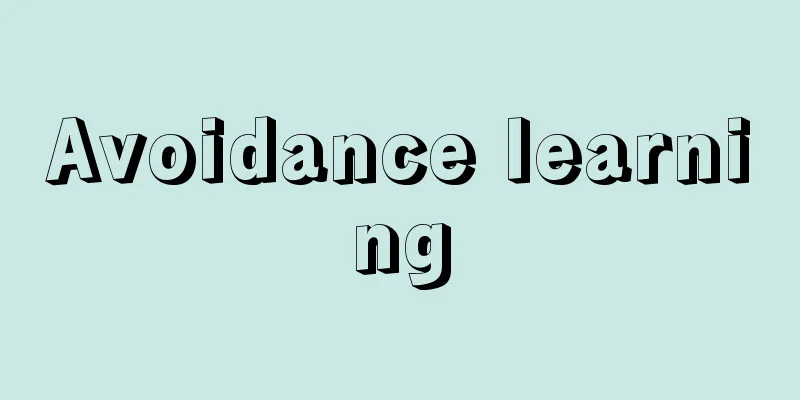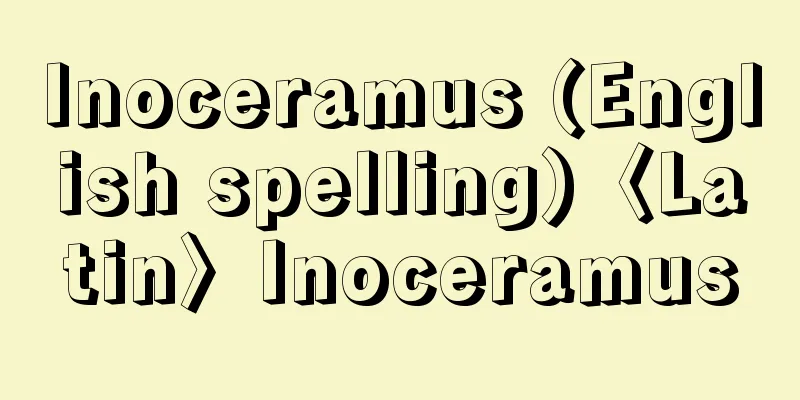Avoidance learning

|
The process of acquiring a certain reaction (or suppression of reaction) to conditioned stimuli that predict an aversive stimulus or a contextual stimulus that predicts an aversive stimulus before the aversive stimulus arrives, thereby avoiding the encounter with the aversive stimulus, is called avoidance learning. In contrast, the process of acquiring a certain reaction (a reaction as a tool for avoidance) to escape after encountering an aversive stimulus is called escape learning. Active avoidance is a situation in which an animal avoids an aversive stimulus by actively emitting a certain reaction on its own. Usually, first there is a stage (escape learning) in which the animal learns how to escape from a given aversive stimulus. If a warning stimulus and an aversive stimulus are repeatedly given in pairs, the animal will predict the arrival of the aversive stimulus and respond to avoid it before it arrives (avoidance learning). Active avoidance includes one-way avoidance and shuttle (two-way) avoidance. In one-way avoidance, the compartment in which the aversive stimulus is given and the compartment in which it can be escaped (safety) have different characteristics (color, floor shape, etc.) and are always consistent. Training for shuttle avoidance learning is performed using a device (shuttle box) consisting of two compartments of the same shape on the left and right that can be moved between, and an electric shock is given to the foot a few seconds after the warning stimulus (e.g. sound) begins. At first, the animal will show various behaviors by trial and error after receiving the electric shock, but when it moves to the opposite room, the sound stimulus stops and the electric shock also stops. As the trial is repeated, the animal will move to the opposite compartment more quickly. If the experiment is repeated, the subject will move to the next compartment during the period before the warning stimulus is presented, and will end the warning stimulus without receiving an electric shock. Shuttle avoidance learning has the advantage that the experimenter can continue training continuously without touching the subject for each trial, but it is important to note that the animal will be placed in a kind of conflict situation, since it will avoid the aversive stimulus by returning to the room where it experienced the aversive stimulus in the previous trial. According to Mowrer, OH's two-process theory, avoidance learning consists of two processes. The first stage is the escape learning stage, in which a conditioned stimulus and an unconditioned stimulus (an aversive stimulus) are paired and the process of respondent conditioning of fear of the conditioned stimulus takes place. In the second stage, even in the absence of an aversive stimulus, the fear evoked by the conditioned stimulus motivates various behaviors, and if a certain response terminates the conditioned stimulus that is evoking fear, it reduces the fear and reinforces the behavior (the process of instrumental conditioning). Passive avoidance is a situation in which rats and mice passively avoid punishment by suppressing their reaction (not reacting) when placed in the same situation again, based on the experience of receiving punishment such as an electric shock to the leg immediately after displaying an innate reaction tendency in an experimental situation. Therefore, it is also called inhibitory avoidance. Passive avoidance can be classified into step-through type (using a reaction from a bright and large room to a dark and narrow room) and step-down type (using a reaction of stepping down from a platform in the center of the room onto the floor), and the extension of the time (latency) until the movement reaction is made is an indicator of learning. In addition, unlike active avoidance learning, it can be acquired with just one experience, so it is also called one-trial avoidance learning. It has the advantage of being able to clearly identify the time of acquisition (memorization), and for this reason it is often used in animal memory experiments. Sidman avoidance behavior is a special type of avoidance learning (avoidance behavior). In this behavior, no external warning stimuli are given in the operant box, and the elapsed time is used as a cue. Electric shocks are given to the feet at regular intervals (SS intervals), but if the animal makes a lever-pressing response prior to this, it can avoid (extend) the next shock for a certain period of time (RS interval). Therefore, if the animal continues to press the lever at intervals shorter than the RS interval, it can avoid the electric shock. When an organism is repeatedly exposed to an uncontrollable aversive stimulus, it will not show any behavior that tries to deal with the environment by itself, even if it is then placed in a controllable situation. This is called learned helplessness. The effects last for a relatively long time and generalize to a wide range of phenomena. In an experiment conducted by Seligman, M. et al., dogs that had been repeatedly shocked in a situation where they could not avoid the shocks by their own power no matter what they did (an escape-inevitable situation) were then placed in a shuttle box to train shuttle avoidance learning. In that situation, even though they could avoid the shocks by moving to the opposite compartment, they remained crouched and did not try to avoid the shocks. Dogs that were able to deal with the shocks by their own reaction (escape-able) even when exposed to the same amount of shocks were able to learn the avoidance response as quickly as dogs that had not received any shocks beforehand, so the cause was exposure to an inescapable aversive stimulus. This behavior appears to be the result of learning helplessness (resignation), and is considered to be a model of human depression and apathy. In this way, it can be said that the emotion of depression can be acquired through learning, such as conditioning. →Respondent conditioning [Yoshio Ichitani] Latest Sources Psychology Encyclopedia Latest Psychology Encyclopedia About Information |
|
嫌悪刺激を予告する条件刺激や予測させる文脈刺激に対して,嫌悪刺激が到来する前に一定の反応をし(または反応を抑え),結果的に嫌悪刺激に遭遇せずにすむような行動を獲得する過程を回避学習という。これに対して,嫌悪刺激に遭遇してからなんらかの反応(回避する道具としての反応)をして逃げることを習得する過程は逃避学習escape learningとよばれる。 能動的回避active avoidanceは,動物が自ら一定の反応を能動的に発することで嫌悪刺激を回避する事態である。通常はまず,与えられた嫌悪刺激から逃げること(その手段)を学習する段階(逃避学習)がある。予告刺激と嫌悪刺激が対になってさらに与えられつづけると,嫌悪刺激の到来を予測してそれが来る前に避けるための反応を示すようになる(回避学習)。能動的回避には,一方向回避とシャトル(二方向)回避の場面がある。一方向回避では,嫌悪刺激が与えられる区画とそれから逃れられる(安全な)区画は,それぞれ異なる特徴(色,床の形状など)を有してつねに一貫している。シャトル回避学習の訓練は,往来可能な左右の同じ形状の2区画からなる装置(シャトル箱)を用いて行ない,予告刺激(たとえば音)開始の数秒後に足への電撃が与えられる。動物は最初のうちは電撃を与えられてから試行錯誤的にいろいろな行動を示すが,反対側の部屋に移動すると音刺激が停止し,電撃も停止する。試行を繰り返すにしたがって,速やかに反対側の区画に移動するようになる。さらに繰り返すと,予告刺激が呈示されると電撃が来るまでの期間に隣の区画に移動し,電撃を受けることなく予告刺激を終結させるようになる。シャトル回避学習は,1試行ごとに実験者が被験体に触れることなく連続的に訓練を続けることができるという長所があるが,動物にとっては,以前の試行で嫌悪刺激を受けたことがある部屋に戻るという反応によってそれを回避することになるため,一種のコンフリクト事態におかれることになるのを注意する必要がある。 マウラーMowrer,O.H.の二過程説では,回避学習は二つの過程から成る。第1段階は逃避学習の段階で,条件刺激と無条件刺激(嫌悪刺激)が対呈示され条件刺激に対する恐怖のレスポンデント条件づけの過程である。第2段階では,嫌悪刺激がなくとも条件刺激によって喚起された恐怖が,いろいろな行動を動機づけることになり,もしある反応が恐怖を喚起している条件刺激を終結させるとすると,それが恐怖を低減させるのでその行動が強化される(道具的条件づけの過程)というものである。 受動的回避passive avoidanceは,ラットやマウスが実験場面で生得的に有している反応傾向を発すると直後に肢への電撃などの罰を受けるという経験により,再び同じ状況におかれたときにその反応を抑制すること(反応しないこと)によって,受動的に罰を回避する事態である。したがって抑制性回避inhibitory avoidanceともよばれる。受動的回避には,ステップスルーstep-through型(明るく広い部屋から,暗くて狭い部屋への反応を用いる)とステップダウンstep-down型(部屋中央の台から床の上に降りる反応を用いる)があり,移動反応をするまでの時間(潜時)の延長が学習の指標となる。また,能動的回避学習と異なり1回の経験でも習得できてしまうため,一試行回避学習ともよばれる。習得(記銘)時点が明確にできるという長所をもち,このため動物の記憶実験で多用される。 特殊な回避学習(回避行動)として,シドマン型回避行動Sidman avoidance behaviorがある。オペラント箱内で外的な予告刺激を与えずに時間経過を手がかりとするもので,一定の間隔で足への電撃が与えられるが(S-S間隔),これに先行してレバー押し反応を行なうとある一定の時間,次の電撃が来るのを避ける(延長する)ことができる(R-S間隔)。したがって動物はR-S間隔よりも短い時間の間隔でレバー押し反応を継続していれば,電撃を回避できることになる。 生活体が統制不可能な嫌悪刺激に繰り返しさらされると,その後に今度は統制可能な場面におかれたとしても,自ら環境に働きかけて対処しようとする行動を示さなくなってしまう。このことを学習性無力状態learned helplessnessという。その影響は比較的長期にわたり,かつ広範囲の事象に般化する。セリグマンSeligman,M.らの実験では,どのような行動を行なっても自らの力では電撃を避けられない状況(逃避不可能状態)で繰り返し電撃を経験したイヌを,その後にシャトル箱に入れてシャトル回避学習を訓練した。その場面では反対側の区画への移動によって回避可能な状態であったにもかかわらず,うずくまったまま電撃を回避しようとしなかった。同じ量の電撃を受けても自らの反応で電撃に対処できた(逃避可能だった)イヌは,あらかじめなんら電撃を受けなかったイヌと同様に速やかに回避反応を学習できたので,原因は逃避不可能な嫌悪刺激にさらされたことにあった。この行動は,あたかも無力感(あきらめ)を学習した結果のように見え,ヒトのうつ病や無気力症のモデルと考えられている。このように「うつ」の情動は条件づけなどの学習により獲得されうるといえる。 →レスポンデント条件づけ 〔一谷 幸男〕 出典 最新 心理学事典最新 心理学事典について 情報 |
<<: External nostril - external nostril
Recommend
Les Films Albatros (English)
...It was also during this period that "avan...
Choir - Seikatai
A choir that serves in Christian church worship s...
Yoshiko Tachibana - Yoshiko Tachibana
Empress of Emperor Saga. Daughter of Udoneri Tach...
Lead plate - Enban
A type of printing plate used in printing; a repro...
Eurynomē (English spelling) Eurynome
…Therefore, the influence of theories about the o...
Senecio articulatus (English spelling) Senecioarticulatus
…[Ichiro Sakanashi] [Hiroshi Yuasa]. … *Some of t...
Hull strength - strength
Hull strength. When a ship is floating quietly, i...
Aglaia
…In Latin, they are called Gratiae, and in Englis...
Herero Rebellion - Herero Rebellion
A rebellion in 1904 by the Herero people of German...
Pillow words - pillow words
A modifying phrase used mainly in waka poetry. It...
tabula rasa (English spelling) tabularasa
…On the other hand, in British empiricism, the se...
Puy‐de‐Dôme (mountain)
The highest peak of the Dôme massif at the norther...
Deviation from roundness
Circularity is the amount of deviation of a circul...
Osaka University
A national university corporation. Osaka Imperial...
Full lotus position
This is one of the zazen (seated meditation) meth...









